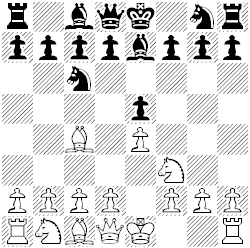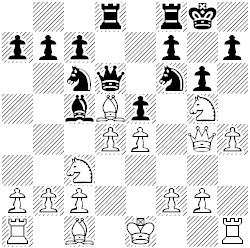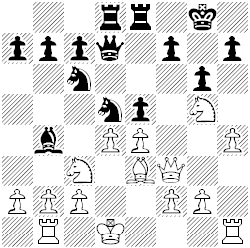 THE MAGAZINE TO BROADEN YOUR CHESS HORIZONS | ||
| Volume 7, issue 45 | ISSN 0958-8248 | August 2004 |
|
Hierarchical Chess
by John Beasley It is no secret that I go to the annual French problem meeting at Messigny for the food and not for the chess. That said, one of its most attractive features is the blitz tournament on the Sunday afternoon. This year, we had no fewer than 14 competitors. After a brief look at Kamikaze Chess (the captor vanishes along with the man captured), which is used in problems but proved quite unplayable as a game, we decided on something which I had not met before: on your first move you play a pawn, on your second a knight, on your third a bishop, and so on round. I failed to catch its name, but John Rice, whose ears are sharper, reported it in The Problemist as Hierarchical Chess. If you have men of the kind due to move and cannot move any of them, you lose; if you no longer have men of this kind, you move a man of the following kind instead (so if you lose your knights your sequence becomes PBRQK, and if you lose your bishops as well it becomes PRQK). This is complicated and the Extinction Chess rule might seem more natural (if you lose all your men of a kind, you lose the game), but in practice it seems to work. Check is normal, and must be countered by a man of the kind which is next to move; castling counts as a rook move. The writing down of five-minute games during play is quite impossible, and what follows will consist of reconstruction and example. Let me start with a typical howler. We had played something like 1 e4 e5 2 Nf3 Nc6 3 Bc4, and in an absent-minded moment I played 3...Be7 (diagram at top of next column) instead of the natural and correct 3...Bc5. As always, there was a reason; I felt like a change, I wanted b4 for my knight (we had already discovered that a knight on its fifth rank could threaten an unstoppable check), and of course I did not want to play ...Bd6 and block my d-pawn. So I blocked my queen instead, and all I could do was laugh and resign (4 Rg1 Rb8 5 Qe2 ???). |

To get a deeper feel for the game, let us play through something more sensible. 1 e4 e5 2 Nf3 Nf6 3 Bc4 Bc5 4 Rg1 (White likes to keep his king in the centre) 0-0 (Black prefers to castle) 5 Qe2 Qe7 6 Kd1 Kh8 :
7 d4 (when playing a new game, space and mobility in the immediate future are likely to be more valuable than an extra pawn later on) d5 (Black agrees) 8 Ng5 (White has visions of Nxf7+ at move 20, after Black has played 12...Kg8 and 18...Kh8) Nc6 (the knight at f6 must stay put to stop Qh5) 9 Bxd5 (this being so, White reckons he can safely take this pawn) Bg4 :
Ouch! In ordinary chess, White would interpose on f3, but here the queen will have to move before the pawn or knight and its move Qf3 will block this square. Never mind. 10 Rh1 Rad8 11 Qxg4! (pardon?) Qd6 12 Ke1 Kg8 13 h4 g6 (trying to give his king some air) 14 Nc3 : |

Too late, Black sees that his intended 14...Nxg4 will allow 15 Bxf7, which is mate (it is check and the check cannot be cancelled by the bishop, which is the next piece to move - this is why White didnt capture it at move 13). He therefore plays 14...Nxd5, but after 15 Be3 Bb4 16 Rb1 Rfe8 17 Qf3 Qd7 18 Kd1 he resigns :
His next move will put his king on a dark square, and White will have an unanswerable knight check at move 20. Its a curious game, usually decided by a snap attack on the king, and a development such as Whites Ng5 above is standard practice. However, there is a fundamental asymmetry in that Black must answer a queen move by a queen move whereas White answers one by a king move, and this would appear to give White a massive advantage (he can give a next-square check with an undefended queen, Black cannot); I suspect that a White win from the game array may be provable by computer. That said, in our present state of knowledge the game is good fun. For the record, the tournament was won by Eric Huber with 11 out of 13, ahead of Joachim Iglesias and Alain Villeneuve (author of the standard French textbook on orthodox chess endings, and always charmingly willing to have a go at something new). |
Selected articles from Variant Chess appear here on the Chess Variant Pages with the permission of the British Chess Variants Society (BCVS). We feel that this journal is exceptional, and have entered into an agreement with the BCVS to publish certain of their articles on our pages in return for advertising.



